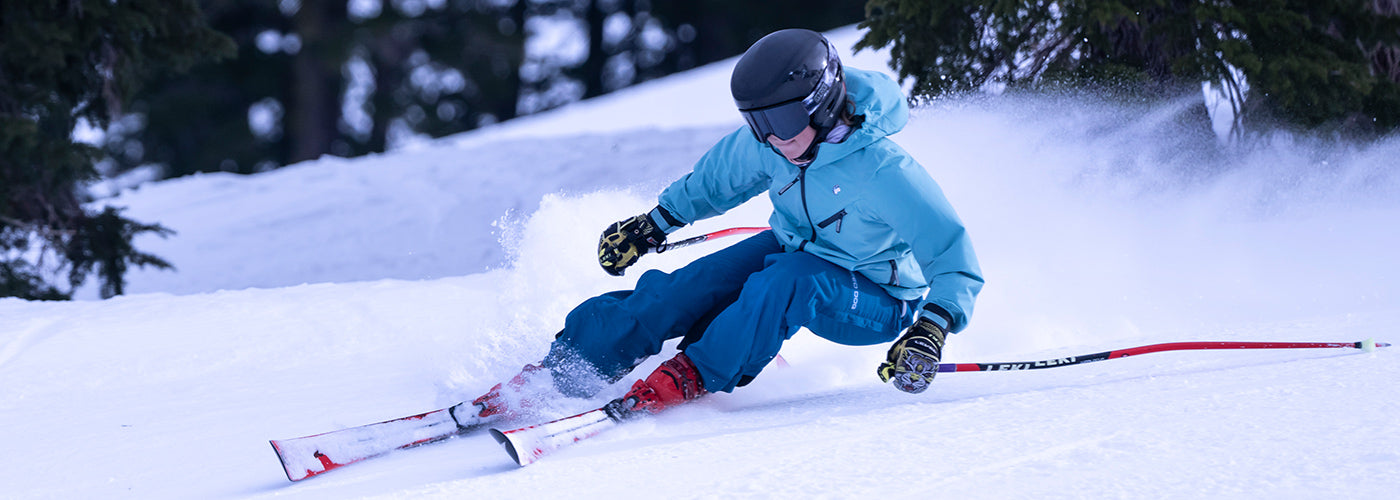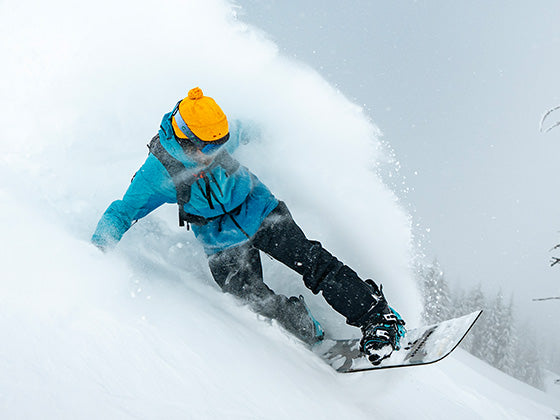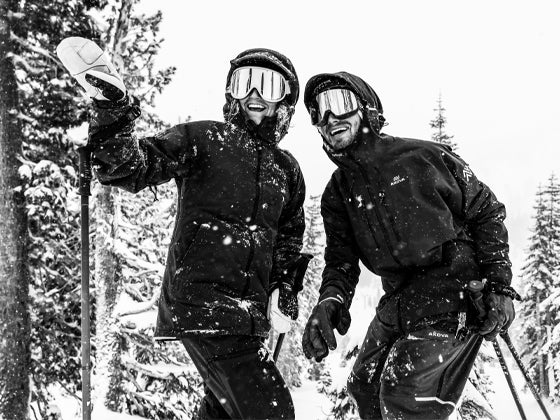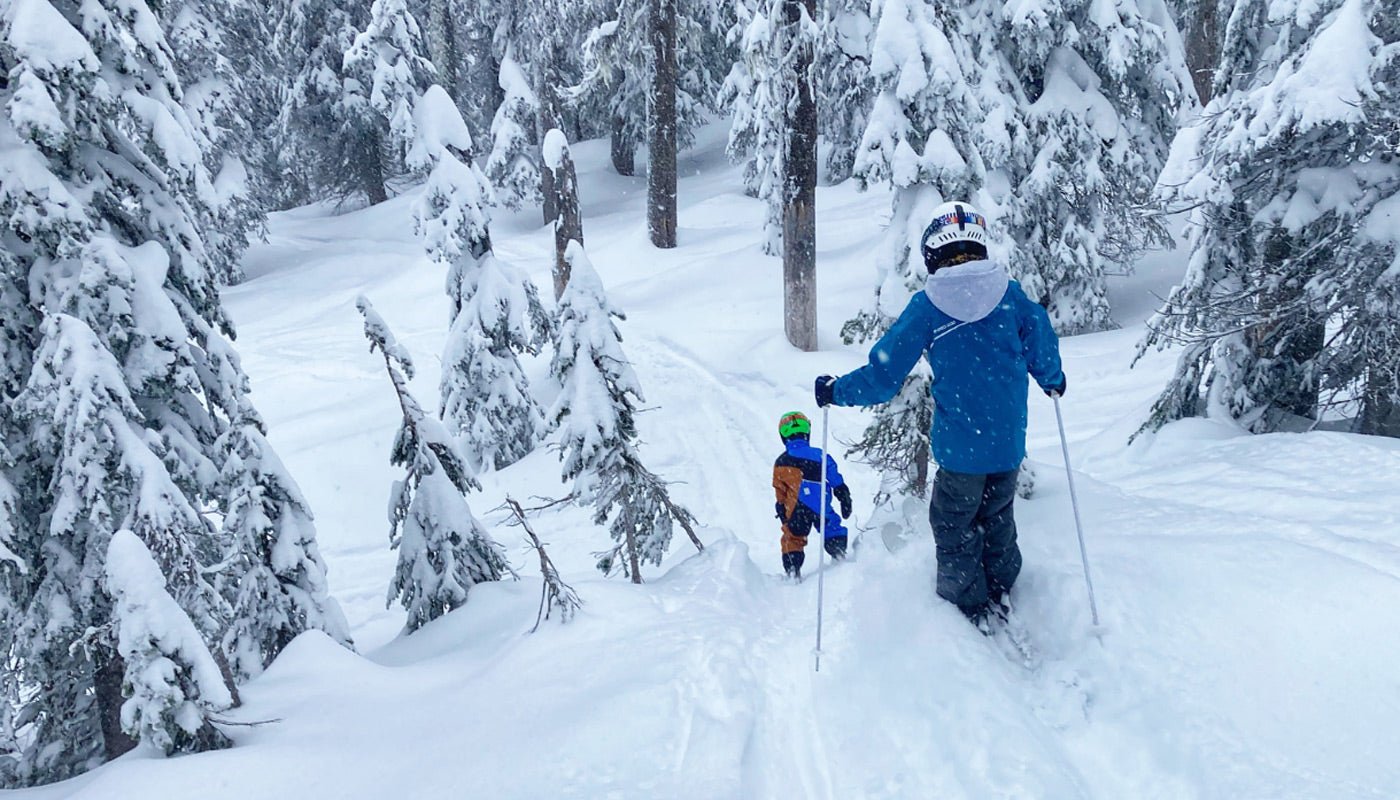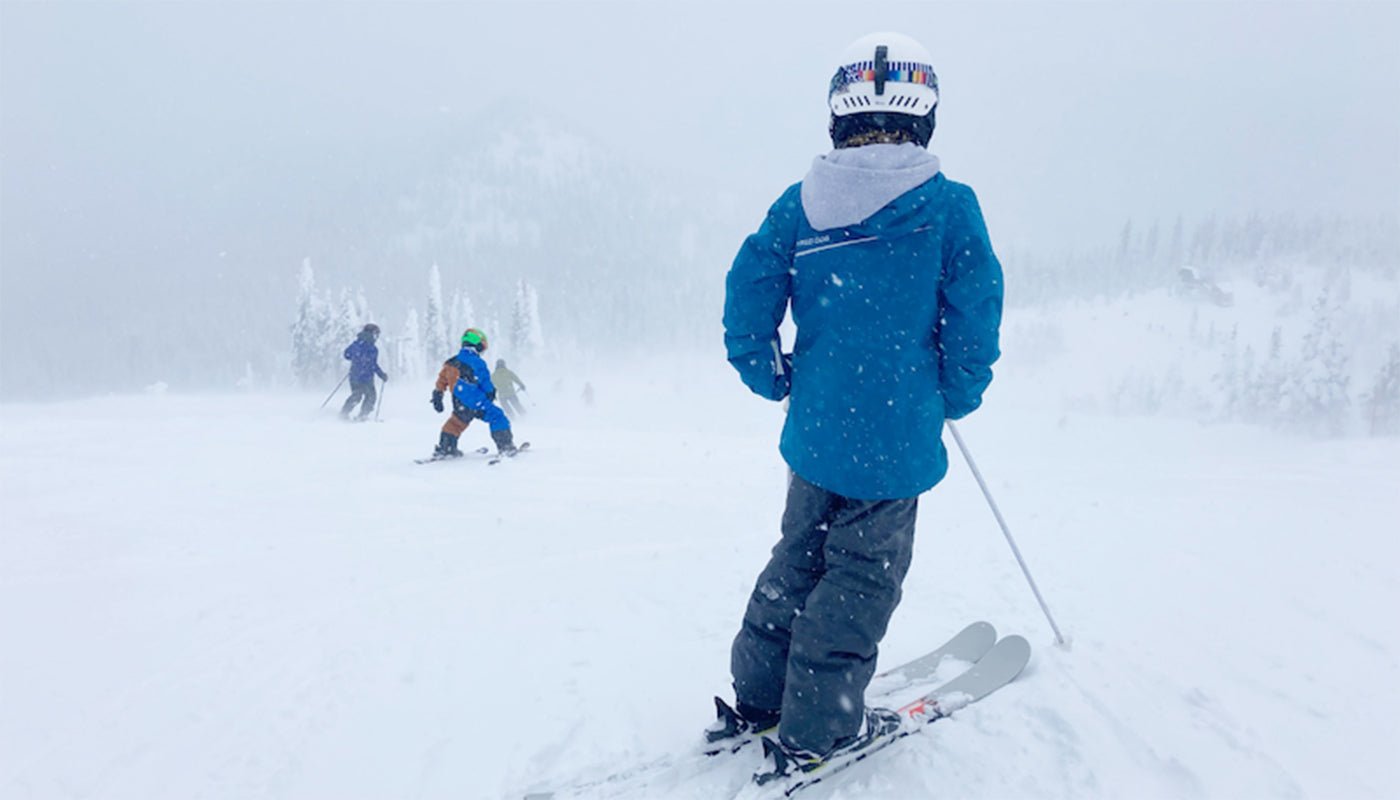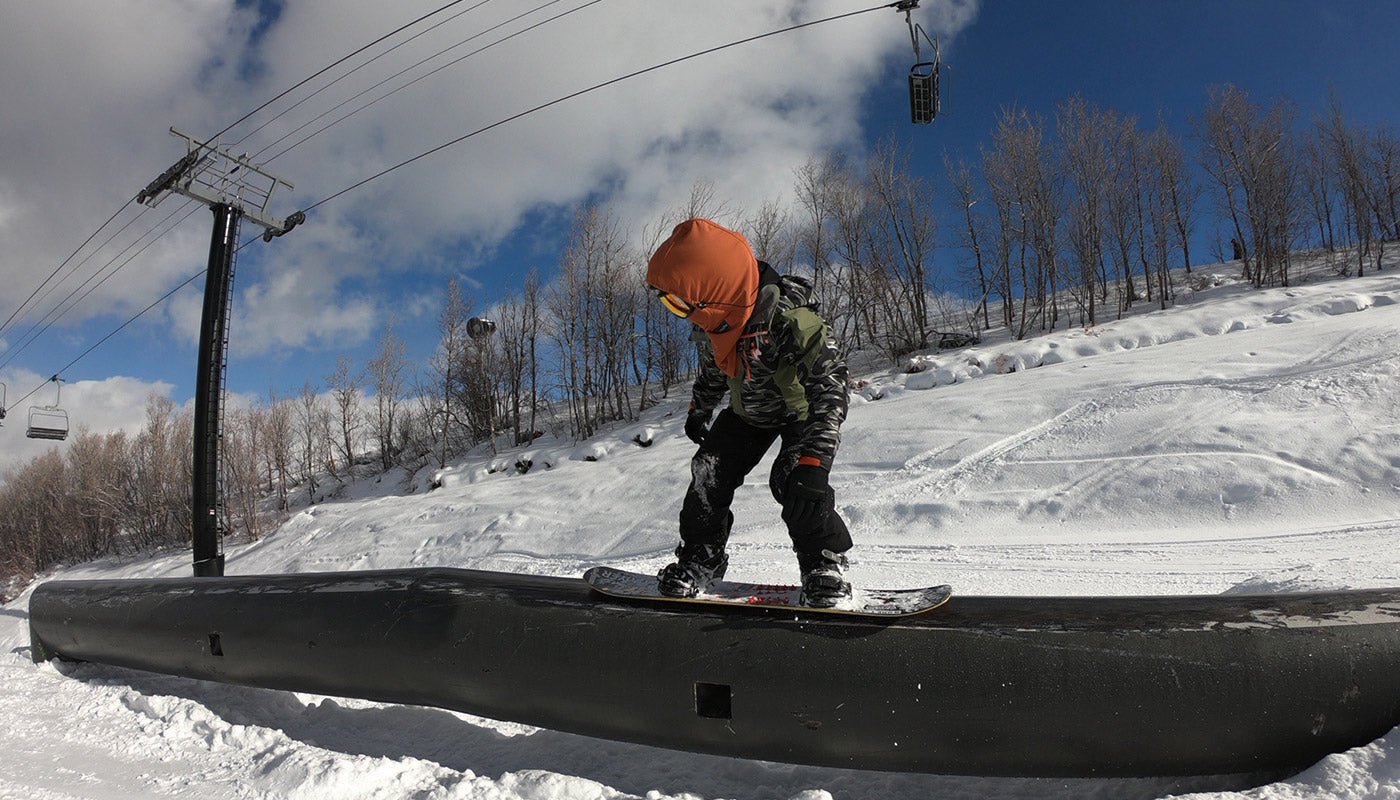Welcome to Safety on the Slopes: A 3-part Guest Series from Raising Little Rippers
Raising Little Rippers is a blog and set of online educational resources created by 22-yr ski instructor and mom, Janelle Thomas. We are partnering with her to bring you some of her sage advice and invite you to learn more with her online course to help kids stay safe on the hill (see below for more info).
Part 1: Teaching Kids About Tree Wells
Staying safe around tree wells is a topic that I don’t think is taught to lil’ rippers often enough. It’s easy to have a false sense of security while skiing and riding inbounds at a ski resort, yet natural obstacles exist that can be just as dangerous as avalanches, due mostly to our relaxed nature and lack of knowledge. The following information is important for anyone who rides around tree wells, even if those tree wells are along the edge of a groomed run and especially while riding through the trees. Use this article to arm your lil ripper with knowledge that will help to keep them safe for a lifetime of mountain adventures!
As you approach the topic of tree wells with your child, try to remember that there can be a fine balance between teaching children about risk and scaring the desire to explore right out of them. Always take your child's age and personality into consideration when deciding when and how to share this information with them. Though the consequences can be quite scary, we don’t ever want to approach the tree well conversation with a doom and gloom kind of attitude. At the same time we DO want to stress the true risk that exists when we ski and ride terrain with trees. My advice is to keep the tone of the conversation all about empowering ourselves with the knowledge we need to stay safe. Knowledge is power and this knowledge will help us mitigate these risks the best that we can.
First let’s tackle the nitty gritty... what is a tree well?
A tree well is formed when the snow accumulates around the base of a tree, but not under the lower branches or around the trunk. This hole around the trunk of the tree gets progressively deeper with every snowfall and can behave like quicksand if you fall into it. Tree wells are most dangerous right after a big storm, or anytime the trees are covered in snow. This is because when a skier falls in, they knock the snow off the branches and it falls in on top of them, burying them like an avalanche. Through language and images we often describe a tree well as "a large hole under a tree". The reality is, tree wells are most often hidden by snow and do not look like large holes at all. Also note that trees don’t have to be large to have deep tree wells. Some of the smallest trees can have the deepest wells. Rule of thumb... assume there is a tree well at the base of EVERY tree. In this video my son Tanner demonstrates how hidden a deep tree well can be, by sticking his pole in the snow at the base of a small tree:
Next, let’s talk about habits...
What can you teach your lil’ ripper to keep them safe around tree wells?
1. Practice The Buddy System
We have one very strict rule in our household and it has nothing to do with chores or screen time. It has to do instead with skiing the trees… NEVER ENTER FORESTED TERRAIN WITHOUT A BUDDY. Why?
Because 90% of people involved in tree well hazard research experiments could NOT rescue themselves. So let’s talk about the best reason in the world to ski with a buddy. If you fall into a tree well and you are riding with a buddy who HAS THEIR EYES ON YOU , there is a good chance you will get out alive. It is always the riders who were riding alone, or lost contact with their buddy that don’t make it. Skiing with a buddy is kind of like wearing a seat belt. It’s the smart thing to do! Before I go any further I want you to note that I highlighted “has their eyes on you” above because when it comes down to it, if you do not see your buddy or they do not see you, then you might as well not have a buddy at all. This can be a tough one to teach our kids because they are used to us being the ones keeping an eye on them, but the buddy system requires them to also keep an eye on you. Sometimes this means we take just a couple turns and stop so our buddy can ski by. Sometimes it means we ski side by side or like a train communicating back and forth verbally. It can be easy to loose track of your buddy in the trees so believe it or not pulling the buddy system off correctly takes practice. Teach them young. Start now and watch it become a habit.

Toddler Tip: The best way to teach young children the buddy system is to play a form of leap frog. One of you skis three or four turns and stops, then looks uphill to watch their buddy who skis three or four turns past them and then stops. Back and forth, continue leap frogging like this through the trees.
2. Focus On The Space Between The Trees
Most kids have heard this when learning to ride a bike… LOOK WHERE YOU WANT TO GO. If you don’t want to go near the tree wells you have to make sure you are not looking at the trees. Teach your lil’ ripper to always keep their eyes focused on the “space between the trees”. To always be looking where they want to go. Seems simple. Takes practice!
3. Know When To Bail
Sometimes it just happens that you’re skiing through the trees and looking where you want to go and you crash anyway. If you fall with your head down the hill you can easily tip or slide into a tree well head first. The rule of thumb is: if you feel out of control or are headed towards a tree, bail before you get there.This means to
sit down, on your hip, with your skis down the hill. It’s a good idea to practice how to bail and be comfortable with it before skiing through the trees. Practicing this maneuver will create muscle memories that will help you respond quickly if you are panicked or caught off guard.
Toddler Tip: Teach your lil’ ripper how to bail starting their first day on ski’s. Teaching them to fall safely can save them from some pretty hard crashes. They need to know that if they ever feel out of control, like they might hit someone or something, it is better to “bail” than it is to continue. Teach them to sit down on their hip (not their butt), skis across the hill and down below them. Feet first is the motto!
4. Carry A Whistle
Make it a habit to carry a whistle. Attaching it to the outside of a jacket seems to work best. Somewhere that it can be easily grabbed and used in case of emergency. Blowing a whistle while out in the mountains is a universal sign for help. If you find yourself in a tree well your lil’ ripper is going to need assistance to get you out. Be sure they have access to a loud whistle and know how to use it in case of emergency.
5. Remove Your Pole Straps
Believe it or not it is dangerous for you to ski down the hill with your pole straps wrapped around your wrists. These straps are great for skinning uphill but when skiing downhill and especially when skiing trees, you should take them off for your safety. Keeping those straps on your wrists runs you the risk of dislocating a shoulder, breaking a wrist or worse yet making it near impossible for you to be rescued from a tree well. If strapped to your wrists when you go down in a tree well those straps can make you feel like you're in handcuffs, hampering your efforts to escape or clear air space to breathe. When these dangers were shared with us by our local ski patrol I simply started making it a habit to cut the straps off all of our poles. Old or new, they all get cut off. They always just got in the way anyway.
6. Carry Rescue Gear
If you only ski the trees on occasion this tip is not really for you but, if you ski the deep trees often and/or are working towards skiing in the backcountry with your family, it’s never a bad idea to get in the habit of skiing with a backpack full of rescue equipment. The two devices that could be of good use in a tree well immersion are both a shovel and an avalanche beacon (to help with location if needed). A shovel is especially helpful to a child tasked with the job of digging
you or another buddy out. Always practice and get comfortable using these tools before taking them out on the hill.

Last, let’s discuss what to do… if you do fall into a tree well:
1. Try grabbing the branches or the trunk of the tree as you fall in, to prevent you from sliding further into the hole.
2. Do not struggle, stay calm because struggling can cause you to sink and will pack more snow in around you.
3. Your job is to make an air pocket around your face and wait for rescue.
And what to do if your buddy falls into a tree well:
1. If you cannot immediately locate your missing buddy, call ski patrol first, then continue searching for them.
2. Listen for muffled shouting, if you can see your buddies tracks follow them. Remember if snow fell in behind them it will be hard to see their skis or snowboard. They could even be buried completely.
3. Blow your whistle and yell for help to attract other riders in the area. Time is of the essence. The more eyes and hands the better.
4. When you find your buddy do not release them from their equipment as they may fall further into the hole.
5. If you can not easily pull your buddy out the way they fell in, you need to determine where their head should be and tunnel in from the side. Be careful not to knock more snow into the hole.
6. After you tunnel an airway, continue to expand the tunnel until you can pull your buddy out.
Conclusion
Riding untouched powder through the trees can be pure magic and when done safely can be enjoyed with low risk. Teaching your lil’ ripper about tree wells and instilling habits while they are young, will help them to make good choices for a lifetime.
Want to learn more about safety or shred dog gear?
Check out Part 2 and Part 3 of this series on avoiding collisions or visit Raising Little Rippers to read Coach Nelly's SHRED DOG gear review.
About the author

